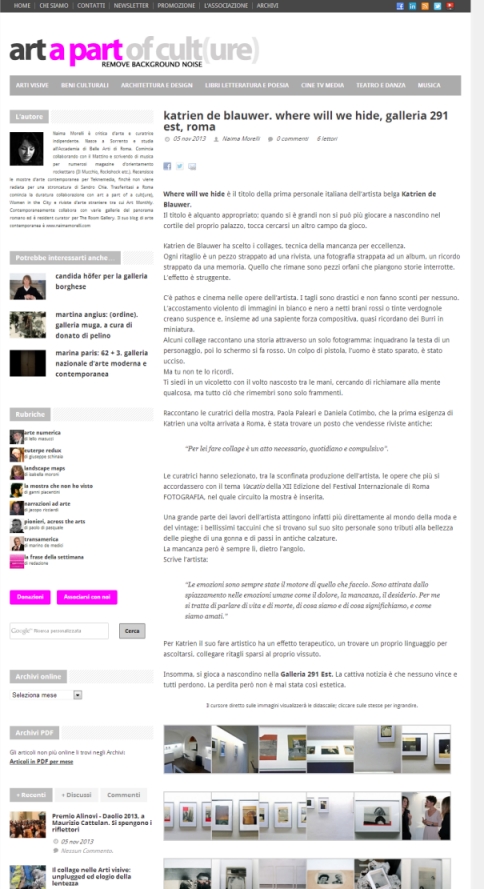
The Italian web magazine Art a Part of Cult(ure) has just published my review of the Katrien de Blauwer’s exhibition “Where will we hide” at Galleria 291 est, Rome.
Here you are the link to the review
Read More
The Italian web magazine Art a Part of Cult(ure) has just published my review of the Katrien de Blauwer’s exhibition “Where will we hide” at Galleria 291 est, Rome.
Here you are the link to the review
Read More
My article “An artist in a waitress’s body” is in the November issue of Art Monthly Australia. The article features interviews with artsHub director Deborah Stone and artists Georgina Lee and Boe-Lin Bastian. The interview is part of my reportage about emerging artists in Melbourne.
Here the link to the Art Monthly Au website
Read More
“The Act of Killing” is the kind of movie that shuts you up for at least fifteen minutes after the credits. It makes you so uncomfortable that you can just chatter about irrelevant stuff with your friends out of the cinema.
Then, on the tram the way home, you suddenly burst in wordiness.
What happened is that “The Act of Killing” has finally been screened in Italian cinemas.
I went to see it the other day with a group of friends at the “Cinema Aquila”, in Pigneto, Rome.
The Act of Killing is an unconventional documentary film directed by Joshua Oppenheimer.
The film deals with the systematic slaughter of real or supposed communists in the aftermath of a failed coup in 1965 that led to General Suharto assuming power.
The director was not interested in gave a full picture of the historical events though. He didn’t even mention Suharto once.
The documentary revolves instead around the character of Anwar Congo, a leader of paramilitary organisation Pancasila Youth, whose job was to kill prisoners.
Because the historical picture was only hinted, I wouldn’t say it is a movie specifically about Indonesia’s ’65.
I would rather say it’s a movie about “the act of killing” itself, the psychology of the killer and the banality of evil.
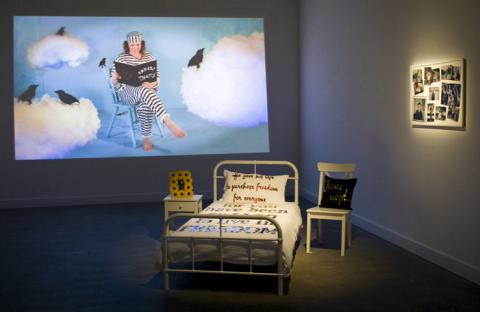
Bindi Cole is one of the first artists I interviewed in Melbourne.
I come to know about her work during the presentation talk of “Melbourne Now” exhibition at the NGV.
Her work span through different mediums, from photography to installation, and the themes are often related to her personal history and aboriginal issues.
She constantly challenges stereotypes, revealing overlooked complexities behind communities and identities. In the series “Not Really Aboriginal” she photographed her family and herself with black painting on their face. The title refers to the accusation that some people addressed to her, that of not being “really” Aboriginal, because of her anglosaxon aspect and her light skin.
One of her most challenging work is “Sistagirls”, a photographic series about the transgender community of the Tiwi Islands.
Recently Bindi Cole decided to reflect on her personal history, mainly through video and installations. Even if she went through tough times, her vision underlies a constant optimism and reveals the beauty of the human experience.
I find her recent installation with emu feathers “I Forgive You) (currently exhibited at Queensland Art Gallery) just moving.
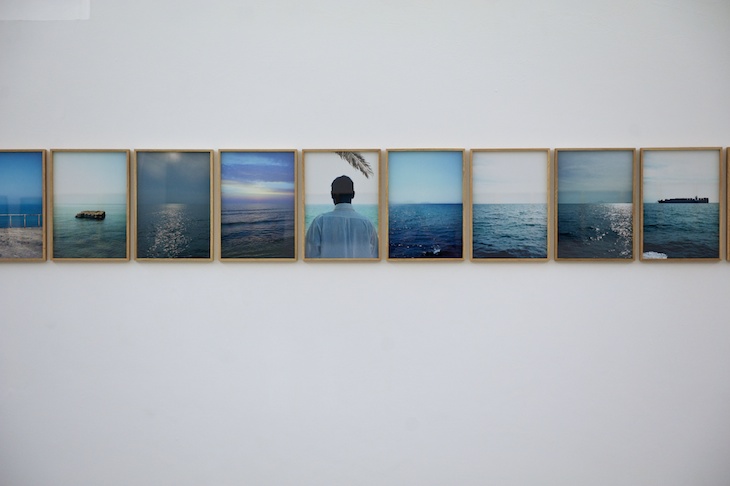
We have seen plenty of celebrations of the sea. The only subject that is as hackneyed as the sea is the sky. And love.
But really, to be innovative is not to talk about a new subject for the first time. To be innovative is to be able of talking about a corny subject in a new, or personal or moving way.
If you are a musician, go ask Ivano Fossati about it. If you are a painter, ask Piero Guccione. If you are a photographer, do what Monitor Gallery did. Go ask Antonio Rovaldi.
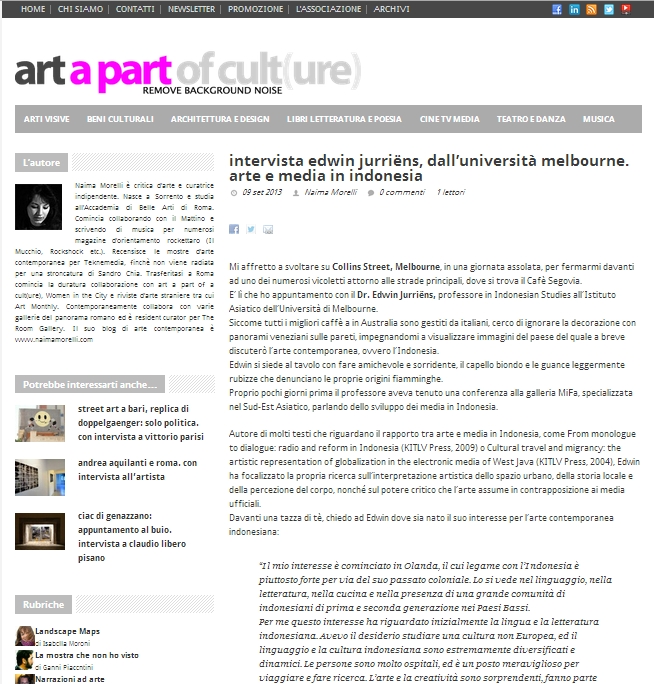
The Italian web magazine Art a Part of Cult(ure) just published the interview I had in Melbourne with Edwin Jurriëns, lecturer in Indonesian Studies at Melbourne University. The interview is part of my reportage about contemporary art in Indonesia.
Here you are the link to the interview
Read More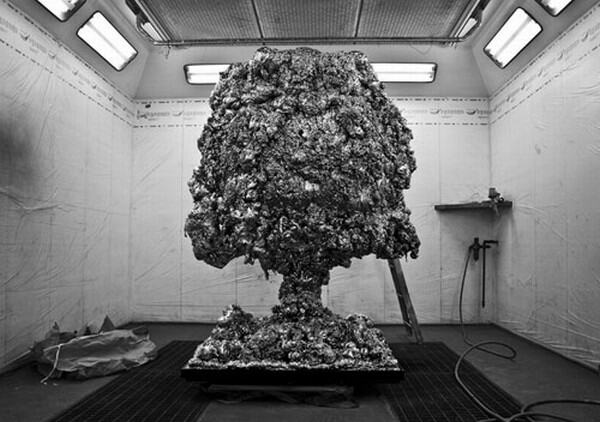
“Incalzatrice della storia Freno del tempo Tu Bomba / Giocattolo dell’universo Massima rapinatrice di cieli Non posso odiarti”
Correndo giù per Via dei Mille nel caldo di un aprile napoletano del duemilaundici, cercando di arrivare al Molo Beverello in tempo per prendere l’Aliscafo dell’una e cinque, vale a dire essere a Sorrento per le due meno un quarto circa, ecco in questa corsa (perché si sa che il movimento fa arieggiare il cervello, purchè non vada in iperventilazione) le immagini della mostra di Zabetta si sovrappongono, si alternano in rima baciata, alternata, incrociata e slogata ai versi di “Bomb” di Gregory Corso.
Sulla rampa di legno vigilata dai Vucumprà, a fianco al Maschio Angioino, inevitabilmente parole e immagini sono già tutta una pappetta, sbatacchiate come un frullatore nella mia testa, non resta che sedersi sull’aliscafo e fare un po’ di ordine.
Dunque, Coda Zabetta non penso proprio che abbia scritto una lettera d’amore alla Bomba, quello è stato Corso. Piuttosto quello di Coda Z. si tratta di un lavoro ordinato che ha condotto a un risultato efficace, puntuale e profetico, come ci hanno tenuto tutti quanti a rimarcare con occhi da Cassandra color acque di Mergellina, alludendo chiaramente alla recentissima tragedia nucleare giapponese.

I recently interviewed the artist Twoone (Hiroyasu Tsuri) in his studio in Collingwood.
The studio was quite empty because he had brought all the paintings at the Backwoods gallery, for his upcoming solo show “Define Nothing”.
Twoone’s Japanese background is evident in his paintings’ balanced composition. His mystical-looking characters with animal heads, realized in his unique style, are his trademark in the Melbournian thriving street art culture.
The exhibition has been a success. I took some pictures of the Twoone’s artworks in the gallery, and then I followed him in a street nearby where he was painting a wall.

Oky Rey Montha is an interesting pop-surrealist artist from Indonesia.
I already wrote a post about one of his painting “Dark Venice” here.
Oky just had a big solo show in the Galeri Canna in Jakarta. The title of the exhibition “Brigitta Queen” is referred to his new character, a mysterious girl from Moscow with her face constantly hidden behind a mask.
Here you are a gallery of photographs from the exhibition that can give you an idea of Oky Rey Montha’s visionary world: